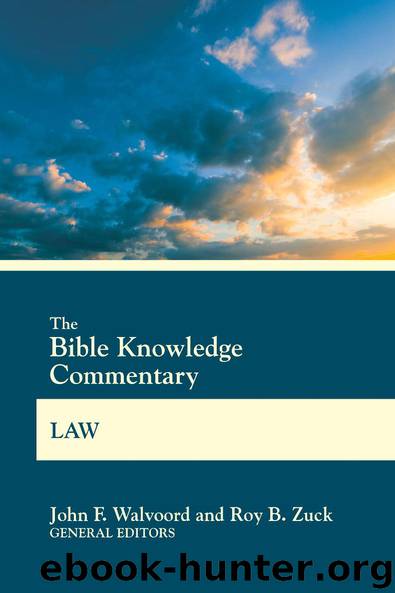The Bible Knowledge Commentary: Law by Unknown

Author:Unknown
Language: eng
Format: epub
Tags: noah;expdus;numbers;Levi;leviticus;mount moriah;rituals;noahs family;cities of refuge;canaan;abraham's travels
Publisher: David C. Cook
Published: 2018-02-16T15:37:59+00:00
The next step in the ritual passed to the priest who caught the blood in a bowl as the animal was slain and then splashed it on all four sides of the altar of sacrifice. This was done, at least in later times, by throwing it against two opposite corners of the altar so that blood splashed on all sides.
1:6-9. The person who was to skin the burnt offering and cut it into pieces was the worshiper, not the priest (cf. v. 12). He was also to wash the animal’s inner parts (v. 9) and hind legs (i.e., those portions defiled by excrement), while the priest arranged the wood (v. 7) and then the pieces of the animal, including the head and the fat (v. 8, more carefully defined in 3:3-4 in the case of the fellowship offering where only the fat was burned), on the fire on the altar. The instruction for the priests to put fire on the altar (1:7) is difficult to understand since at the ordination of the priests (chaps. 8--9), the national festivals (Num. 28--29), and numerous individual occasions sin offerings were offered before burnt offerings, so the fire would already be burning. In fact the fire was not to be allowed to go out between the daily morning and evening sacrifices (Lev. 6:12-13). Perhaps the expression is a general one to indicate priestly responsibility to care for the fire. The uniqueness of the burnt offering is made evident in that the priest was to burn the animal in its entirety on the altar. That the burnt offering was an aroma pleasing to the LORD is an anthropomorphic expression indicating the Lord’s approval and acceptance of the completed sacrifice.
(3) A burnt offering from the flock. 1:10-13. In the case of a burnt offering of a sheep or goat, the same individual characteristics (a male without defect, v. 10; cf. v. 3) and the same ritual procedure, though not spelled out in as much detail (cf. vv. 3-9), were in effect. The only additional clarification is that the slaughter was to be at the north side of the altar (v. 11; cf. comments on vv. 3, 5). Ingenious suggestions have been proposed as to the significance of this location, but probably it was simply the most vacant area adjacent to the altar.
(4) A burnt offering of birds. 1:14-17. The offering of a dove or a young pigeon was permitted for the poor in the case of a burnt offering or a sin offering (5:7), and was prescribed for certain purification offerings (15:14-15, 29-30; Num. 6:10- 11). The small size of the bird required a simplification of the sacrificial ritual so that all was done necessarily by the priest. According to Rashi (cited by Norman H. Snaith, Leviticus and Numbers, p. 32), the priest wrenched off the head of the bird with his fingernail close to the nape, through the neckbone, the windpipe, and the gullet. Then the blood was drained out to the last drop beside the altar.
Download
This site does not store any files on its server. We only index and link to content provided by other sites. Please contact the content providers to delete copyright contents if any and email us, we'll remove relevant links or contents immediately.
International Integration of the Brazilian Economy by Elias C. Grivoyannis(98844)
The Radium Girls by Kate Moore(11970)
Turbulence by E. J. Noyes(7977)
Nudge - Improving Decisions about Health, Wealth, and Happiness by Thaler Sunstein(7656)
The Black Swan by Nassim Nicholas Taleb(7055)
Rich Dad Poor Dad by Robert T. Kiyosaki(6513)
Pioneering Portfolio Management by David F. Swensen(6253)
Man-made Catastrophes and Risk Information Concealment by Dmitry Chernov & Didier Sornette(5956)
Zero to One by Peter Thiel(5731)
Secrecy World by Jake Bernstein(4698)
Millionaire: The Philanderer, Gambler, and Duelist Who Invented Modern Finance by Janet Gleeson(4420)
The Age of Surveillance Capitalism by Shoshana Zuboff(4243)
Skin in the Game by Nassim Nicholas Taleb(4201)
Bullshit Jobs by David Graeber(4138)
The Money Culture by Michael Lewis(4132)
Skin in the Game: Hidden Asymmetries in Daily Life by Nassim Nicholas Taleb(3960)
The Dhandho Investor by Mohnish Pabrai(3722)
The Wisdom of Finance by Mihir Desai(3693)
Blockchain Basics by Daniel Drescher(3540)
